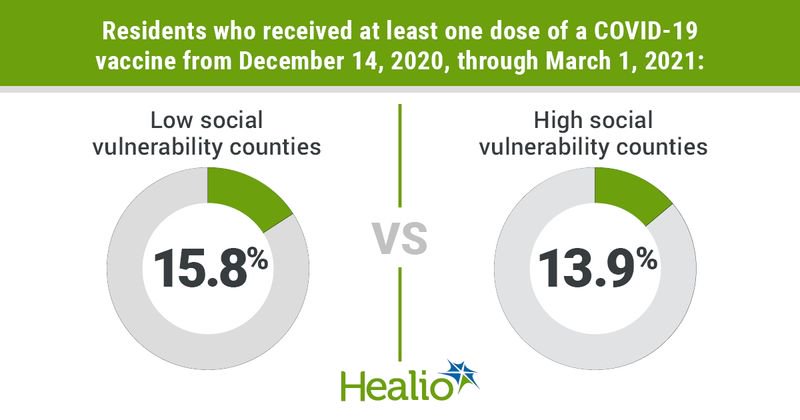Counties with high social vulnerability have lower COVID-19 vaccination coverage
U.S. counties with high social vulnerability had lower COVID-19 vaccination coverage rates than counties with low social vulnerability during the first few months of rollout efforts, according to research published in MMWR.
“Ensuring equitable COVID-19 vaccine access is a priority for the U.S. COVID-19 vaccination program,” Michelle M. Hughes, PhD, an epidemiologist at the CDC, and colleagues wrote. “In the first 2.5 months of the program, vaccination coverage was lower in high vulnerability counties nationwide, demonstrating that additional efforts are needed to achieve equity in vaccination coverage for those who have been most affected by COVID-19.”

Hughes and colleagues used the CDC’s social vulnerability index (SVI), which is based on 15 indicators divided into four themes — socioeconomic status, household composition and disability, and racial/ethnic minority status and language — to create an overall SVI measure, with a total of 20 metrics that are ranked nationally and by state-specific county. They then used these rankings to divide counties into tertiles to define them as having low, moderate or high social vulnerability.
The researchers examined data reported to the CDC from December 14, 2020, through March 1, 2021, to determine COVID-19 vaccination coverage — the number of residents who received a dose of the vaccine — in each county, using total county population to establish coverage estimates.
A total of 49,264,338 U.S. residents from 49 states and Washington, D.C., who received a dose of the COVID-19 vaccine during the study period and had information available on their county of residence were included in the study.
Hughes and colleagues determined that, nationwide, the first-dose vaccination coverage rate was 15.1% during the study period.
They found that for overall SVI, low vulnerability counties had a vaccination coverage rate of 15.8%, which was 1.9 percentage points higher than the 13.9% coverage rate in high vulnerability counties.
According to the researchers, the same pattern of vaccination coverage was observed with all four SVI themes. The greatest difference in vaccination coverage was for socioeconomic status, which had a 2.5 percentage-point difference between low and high vulnerability counties.
In state-level analyses, just two states — Arizona and Montana — had higher vaccination coverage in high vulnerability counties for all four SVI themes and for overall SVI. Three different states — Alaska, Minnesota and West Virginia — had higher coverage in high vulnerability counties with overall SVI and three of four SVI themes.
Overall SVI measures indicated that there were vaccination disparities in 31 states, with disparities in all four SVI themes observed in 11 of these states.
“As vaccine supply increases and administration expands to additional priority groups, CDC, state, and local jurisdictions should continue to monitor vaccination levels by SVI metrics to aid in the development of community efforts to improve vaccination access, outreach, and administration among populations most affected by COVID-19,” the researchers wrote.

